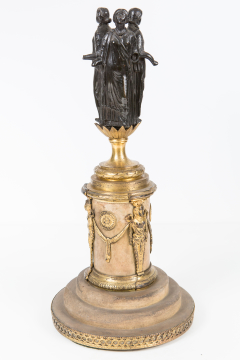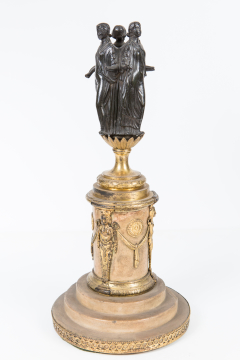Explore Collections


You are here:
CollectionsOnline
/
Statuette of the triple Hecate (or Triform Diana)
Browse
Statuette of the triple Hecate (or Triform Diana)
Ancient Roman bronze, hollow cast through the centre on 18th century pedestal of Derbyshire white marble with ormolu (gilt metal) decoration.
Height: 39cm
Height (bronze): 13.5cm
Height (bronze): 13.5cm
Museum number: A50
On display: Lobby to the Breakfast Room
All spaces are in No. 13 Lincoln's Inn Fields unless identified as in No. 12, Soane's first house.
For tours https://www.soane.org/your-visit
Curatorial note
The three figures of the Goddess have long tresses, a part of which in each case is up in a bun behind the head; they each wear a sleeved Ionic chiton, pinned by a series of shoulder fastenings, and over this in all cases a sleeveless Doric garment which is fastened by a brooch on the right shoulder, which clings to the body and legs in a series of broad, diaphanous folds, and which joins the drapery of the neighbouring figure at the rear where the folds are narrower and vertical.
There are many Graeco-Roman variants of such figures, usually in small marble versions and less frequently in bronze sculpture, of this aspect of Artemis [or Diana; Goddess of the Hunt] or the triple Hecate [Goddess of magic and the Moon]. In these the costuming and attributes of the figures vary considerably, although as would be expected a torch is not uncommonly held between the linked hands of each and a snake is frequently held with or without this as symbolic of the nether regions. The marble statuettes generally show the figures standing against a central kalathos-like pillar; for technical reasons this is omitted to allow for the hollow casting and perhaps functional purposes of the Soane bronze. Cornelius Vermeule [author of this catalogue entry] studied an excellent example in Greek marble which passed through the auction house of Messrs. Spink and Son, London1 and there is a good parallel in the Cassel Gallery in Germany2. These house-hold-shrine size statuettes have been found in the West as far afield as Trier3 and the Amiens area4. They also exist in wood5. In bronze the best complete group is in the Conservatori, Rome6 - a triple-bodied Hecate which in the attributes shows the influence of later religious syncretism, if we consider that Alcamenes seems to have been the first to create the type of the triple Hecate7. The fifth century origins of these figures survive only in the costuming; the torches of the Moon Goddess combined with the snake and dagger of the Erinys [the furies], and the key and rope of the guardian of the Underworld, all suggested restorations for the lost attributes of the Soane figure, belong to the late Hellenistic or Roman period.
This Hekate may be related, in its retrospective classicism, to the so-called "Angerona", a copy of a lost bronze of the fifth century BC, represented by an example in the Soane Museum (SM A36). The prototype is related to the Aphrodite with a dove in the Fogg Museum from the Watkins Collection8.
The bronze is mounted on an ornamental eighteenth century drum altar with stepped base in Derbyshire white marble, with ormolu ('gilt bronze') decorations (herm figures, garlands and rosettes with rings of guilloche ornament around two of the steps (missing from the others but would have been present originally). This base has been identified by Sir Nicholas Goodison as the work of Matthew Boulton and almost certainly made at his Soho Works in Birmingham c.1760-1780.
This bronze occupied various different positions during Soane's lifetime and at the time of his death was in its current position over the doorway between the Lobby to the Breakfast Room,filled with Museum objects and the more domestic front part of No. 13 - in that position Hekate is appropriately placed over a threshold.
1 1953 A.C. Cooper photograph no.154757.
2 Bieber, Cassel, p. 59, no. 148, pl. XLII; for the types see Petersen, Archäol. epigr. Mitt aus Österreich, IV, 1880, p. 141ff.; V, 1881, p.1ff. and Sitte, JOAI., XIII, 1910, p. 87ff., pls. III, IV.
3 Cp. Espérandieu, VI, p. 233, no. 4947, Trier Museum.
4 V, p.163, no. 3935: Reinach, RS, II, p. 322, no. 5, a larger figure; compare also the others reproduced in p. 322f. [note to check this reference: not sure what 'V' is]
5 AJA, 44, 1940, p. 293ff.
6 Jones, Cons., p. 285f., no. 1, pl. 114.
7 Pausanias, ii, 30.2. Alcmenes was a Greek sculptor of the 5th century BC.
8 No. 1960.666; Frederick M.Watkins Collection, Cambridge, Massachusetts, 1973, no.6.
There are many Graeco-Roman variants of such figures, usually in small marble versions and less frequently in bronze sculpture, of this aspect of Artemis [or Diana; Goddess of the Hunt] or the triple Hecate [Goddess of magic and the Moon]. In these the costuming and attributes of the figures vary considerably, although as would be expected a torch is not uncommonly held between the linked hands of each and a snake is frequently held with or without this as symbolic of the nether regions. The marble statuettes generally show the figures standing against a central kalathos-like pillar; for technical reasons this is omitted to allow for the hollow casting and perhaps functional purposes of the Soane bronze. Cornelius Vermeule [author of this catalogue entry] studied an excellent example in Greek marble which passed through the auction house of Messrs. Spink and Son, London1 and there is a good parallel in the Cassel Gallery in Germany2. These house-hold-shrine size statuettes have been found in the West as far afield as Trier3 and the Amiens area4. They also exist in wood5. In bronze the best complete group is in the Conservatori, Rome6 - a triple-bodied Hecate which in the attributes shows the influence of later religious syncretism, if we consider that Alcamenes seems to have been the first to create the type of the triple Hecate7. The fifth century origins of these figures survive only in the costuming; the torches of the Moon Goddess combined with the snake and dagger of the Erinys [the furies], and the key and rope of the guardian of the Underworld, all suggested restorations for the lost attributes of the Soane figure, belong to the late Hellenistic or Roman period.
This Hekate may be related, in its retrospective classicism, to the so-called "Angerona", a copy of a lost bronze of the fifth century BC, represented by an example in the Soane Museum (SM A36). The prototype is related to the Aphrodite with a dove in the Fogg Museum from the Watkins Collection8.
The bronze is mounted on an ornamental eighteenth century drum altar with stepped base in Derbyshire white marble, with ormolu ('gilt bronze') decorations (herm figures, garlands and rosettes with rings of guilloche ornament around two of the steps (missing from the others but would have been present originally). This base has been identified by Sir Nicholas Goodison as the work of Matthew Boulton and almost certainly made at his Soho Works in Birmingham c.1760-1780.
This bronze occupied various different positions during Soane's lifetime and at the time of his death was in its current position over the doorway between the Lobby to the Breakfast Room,filled with Museum objects and the more domestic front part of No. 13 - in that position Hekate is appropriately placed over a threshold.
1 1953 A.C. Cooper photograph no.154757.
2 Bieber, Cassel, p. 59, no. 148, pl. XLII; for the types see Petersen, Archäol. epigr. Mitt aus Österreich, IV, 1880, p. 141ff.; V, 1881, p.1ff. and Sitte, JOAI., XIII, 1910, p. 87ff., pls. III, IV.
3 Cp. Espérandieu, VI, p. 233, no. 4947, Trier Museum.
4 V, p.163, no. 3935: Reinach, RS, II, p. 322, no. 5, a larger figure; compare also the others reproduced in p. 322f. [note to check this reference: not sure what 'V' is]
5 AJA, 44, 1940, p. 293ff.
6 Jones, Cons., p. 285f., no. 1, pl. 114.
7 Pausanias, ii, 30.2. Alcmenes was a Greek sculptor of the 5th century BC.
8 No. 1960.666; Frederick M.Watkins Collection, Cambridge, Massachusetts, 1973, no.6.
Purchased by John Soane at the Richard Cosway Sale (Mr.Stanley), 22 May 1821, Lot. 68,The Triform Diana - on a marble pedestal, £2.10.0.
Literature
M.B. Comstock/C.C. Vermeule, Greek Etruscan and Roman Bronzes in the Museum of Fine Arts, Boston, Boston 1971, no 104.
For comparative material on the ormolu mounts see Nicholas Goodison, Matthew Boulton: Ormolu (Christie's, 2002), p.300 and plates 263 and 265.
For comparative material on the ormolu mounts see Nicholas Goodison, Matthew Boulton: Ormolu (Christie's, 2002), p.300 and plates 263 and 265.
Exhibition history
Richard and Maria Cosway: Regency Artists of Taste and Fashion, Scottish National Portrait Gallery, Edinburgh, 11 August - 29 October 1995; National Portrait Gallery, London, 17 November 1995 - 18 February 1996
Soane collections online is being continually updated. If you wish to find out more or if you have any further information about this object please contact us: worksofart@soane.org.uk













